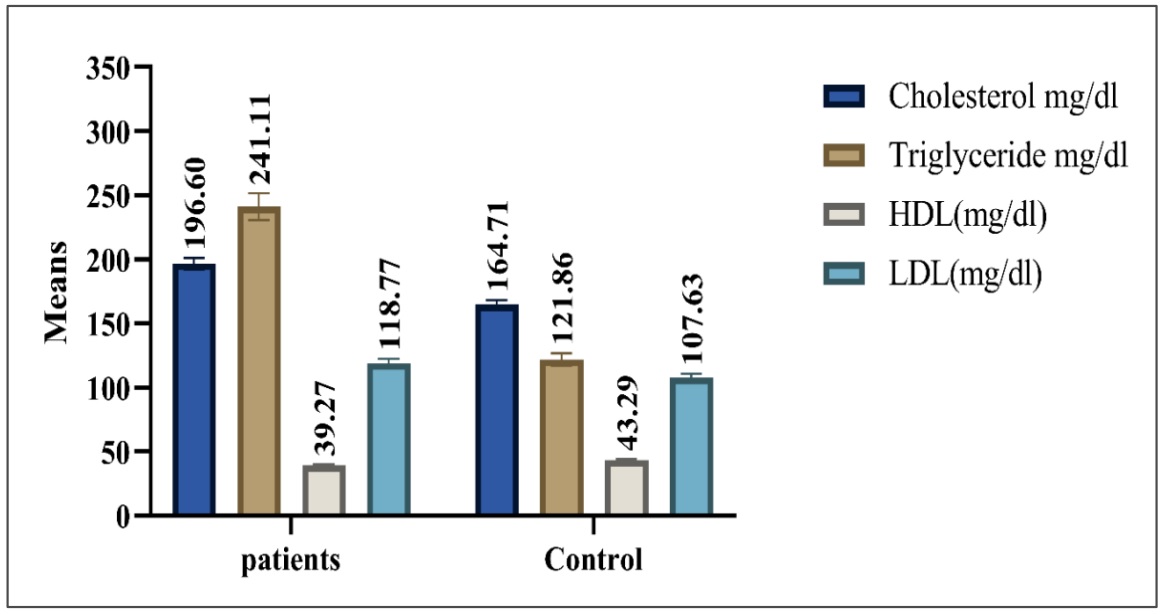Concentration of Asprosin Associated with Poor Control of Type 2 Diabetes Mellitus in Diyala Province
DOI:
https://doi.org/10.51173/jt.v5i2.932Keywords:
Asprosin, Poor Control, Type 2 Diabetes Mellitus, BMIAbstract
A newly secreted adipokine called asprosin is brought on by fasting as well as encourages hepatic glucose release. Its loss of function through immunologic or genetic methods has a significant effect on lowering glucose and insulin as a result of decreased hepatic glucose release. This study aimed to measure the level of asprosin in a group of poor control hyperglycemic patients and compare its level with the control group and find its correlation with obesity and lipid profile. Asprosin level in serum was assessed by enzyme-linked immunosorbent assay (ELISA) technique for 110 Iraqi patients with type 2 diabetes mellitus(T2DM), as well as 70 individual healthy controls. Percentage of glycated hemoglobin (HbAIc), fasting blood glucose (FBG), total cholesterol (TC), triglyceride (TG), high-density lipoprotein (HDL) and low-density lipoprotein (LDL) concentration were calculated using Roche cobas integra 400 plus. Patients with type 2 diabetes mellitus reported increased levels of asprosin in their blood when compared with controls (p < 0.001). A significant positive correlation was seen between asprosin and FBG in patient’s (P< 0.05). Non-significant correlation was seen between asprosin and body mass index (BMI) or lipid profile. In conclusion, according to the asprosin level in serum, there was a highly significant difference between patients with type 2 diabetes mellitus and control group. BMI and lipid abnormalities were not correlated to asprosin level in the serum of patients.
Downloads
References
P. Saeedi, I. Petersohn, P. Salpea., B. Malanda, S. Karuranga., et al. “Global and regional diabetes prevalence estimates for 2019 and projections for 2030 and 2045: Results from the International Diabetes Federation Diabetes Atlas”, Diabetes research and clinical practice. Vol.157, pp.107843, 2019.
R. Kumari , S . Kumar , and Kant R; “An update on metabolic syndrome: metabolic risk markers and adipokines in the development of metabolic syndrome”, Diabetes and metabolic syndrome,vol.13 No.4,pp.2409–2417, 2019.
C. Romere, C. Duerrschmid, J. Bournat, P. Constable, M. Jain,et al; “Asprosin, a fasting-induced glucogenic protein hormone” ,Cell,vol 165; No.3, pp.566-579, 2016.
S. Kajimura; “Adipose tissue in 2016: advances in the understanding of adipose tissue biology”. Nat Rev Endocrinol.; vol.13, No .2, pp. 69–70, 2017 .
C. Duerrschmid, Y. He, C .Wang, C. Li , JC. Bournat, et al; “Asprosin is a centrally acting orexigenic hormone”,Natural Medicine;vol.23, No.12,pp.1444-1453, 2017.
CY. Wang, TA. Lin., KH. Liu, Liao CH, YY. Liu, et al;“Serum asprosin levels and bariatric surgery outcomes in obese adults. International journal of obesity”, vol.43, No.5,pp.1019-1025,2019.
K.Ugur, S.Aydin; “Saliva and blood asprosin hormone concentration associated with obesity”,International journal of endocrinology. vol.2019 , 2019.
Y. Wang , H. Qu , X. Xiong, Y. Qiu, Y. Liao, et al; “Plasma asprosin concentrations are increased in individuals with glucose dysregulation and correlated with insulin resistance and first-phase insulin secretion”, Mediators of inflammation.vol.2018 ,pp.1-7,Oct 2018.
M. Alan, B.Gurlek, A.Yilmaz, M.Aksit , B Aslanipour,et al; “Asprosin: a novel peptide hormone related to insulin resistance in women with polycystic ovary syndrome”, Gynecological Endocrinology. vol.35, No.3, pp.220-223, 2019.
JB. Groener., A.Valkanou, Z. Kender, J. Pfeiffenberger, L.Kihm, et al; “Asprosin response in hypoglycemia is not related to hypoglycemia unawareness but rather to insulin resistance in type 1 diabetes”, PLoS One.;vol.14, No.9, pp.e0222771, 2019.
X. Zhang, H. Jiang, X. Ma, H. Wu, “Increased serum level and impaired response to glucose fluctuation of asprosin is associated with type 2 diabetes mellitus”. Journal of diabetes investigation.;vol.11, No.2,pp.349-355, 2020.
S. Naiemian, M. Naeemipour, M. Zarei, M. Lari Najafi, et al; “Serum concentration of asprosin in new-onset type 2 diabetes”. Diabetology & Metabolic Syndrome.;vol.12, No.1, pp.1-8 , 2020
T. Lee, S. Yun, JH. Jeong, TW. Jung; “Asprosin impairs insulin secretion in response to glucose and viability through TLR4/JNK-mediated inflammation”, Molecular and cellular endocrinology, vol.15, No.486, pp.96-104, 2019.
American Diabetes Association. 2. Classification and diagnosis of diabetes: standards of medical care in diabetes—2019. Diabetes care. Vol.1, No.42, pp.S13-28, 2019.
A. Elnagar, HI. El-Belbasi, IF. Rehan, K. El-Dawy; “Asprosin: a novel biomarker of type 2 diabetes mellitus”,Veterinary medicine in-between health & economy ; vol.55, No.20,pp.333-347, 2018.
H. Atli, E. Onalan, B.Yakar, T.Kaymaz, D. Duzenci, et al; “The relationship of serum asprosin level with diabetic and non-diabetic retinopathy”. European Review for Medical and Pharmacological Sciences , vol.1, No.26,pp.2117-2123, 2022.
MB. Alobaidi, RR. Al-Samarrai, “Correlation between Serum Asprosin Level And Oxidative Stress in Iraqi Patients with Type II Diabetes Mellitus”, Systematic Reviews in Pharmacy,vol.11 ,No.12,1729-pp.1733, 2020.
K. Sharabi, CD. Tavares, AK. Rines, P. Puigserver ; “Molecular pathophysiology of hepatic glucose production”, Molecular aspects of medicine, vol.1 ,No.46,pp.21-33 , 2015.
C. Greenhill ; “Asprosin—new hormone involved in hepatic glucose release”, Nature Reviews Endocrinology, vol.12 , No.6, pp.312, 2016.
JDS chofield, Y Liu, P Rao-Balakrishna, RA Malik, H Soran, “Diabetes dyslipidemia”. Diabetes therapy,vol.7,No.2, pp.203-219,2016.
R. Wang, Lin P., H. Sun, W. Hu; “Increased serum asprosin is correlated with diabetic nephropathy”, Diabetology & Metabolic Syndrome, vol.13 , No.1,pp.1-6, 2021.

Downloads
Published
How to Cite
Issue
Section
License
Copyright (c) 2023 Alaa Abed Mahmoud, Walaa Ismael Jassim, Ahmed Abdul Hussein Mohsin, Ahmed M. Senan

This work is licensed under a Creative Commons Attribution 4.0 International License.
















